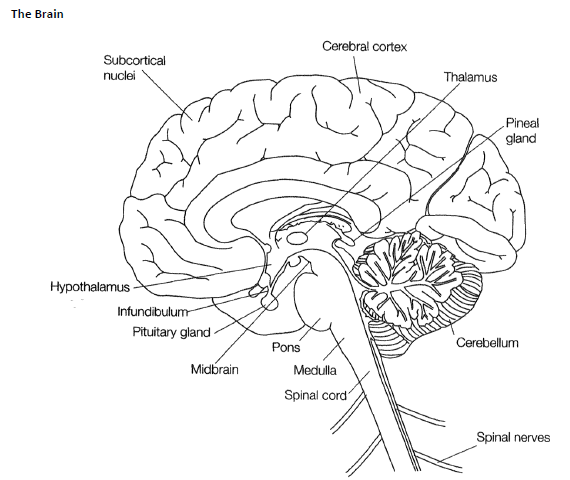
-The medulla oblongata is the most caudal portion of the brain and it is continuous with the spinal cord. The medulla is connected with the cerebellum on either side by the corpus restiforme. The spinal canal widens to form the fourth ventricle in the medulla oblongata. The medulla oblongata contains important centers controlling the heart rate, respiratory rate and depth, vomiting and swallowing.
-The pons lie rostral to medulla. It contains cell bodies of large numbers of neurons that relay information from the cerebral cortex to the cerebellum.
-The cerebellum is situated dorsal to medulla oblongata and the pons. It is concerned with unconscious control, with balance, and with coordination of complex muscular movement. The cerebellum constantly compares the intended movement with the actual movement and makes appropriate adjustment.
-The midbrain is covered dorsally by the cerebral hemispheres. It has a tubular cavity known as cerebral aqueduct. The mid brain is important for eye movement.
-The diencephalon lies between the midbrain caudally and the cerebral hemispheres rostrally and dorsally. It consists of the thalamus, hypothalamus and other structures which are grouped around the third ventricle, the cavity of the diencephalons. The hypothalamus generally controls many body functions including hunger, thirst, body temperature and sleep. More specifically it regulates the autonomic nervous system and hormone secretion of the pituitary gland. The third ventricle of diencephalon communicates caudally with the fourth ventricle through the cerebral aqueduct. On either side the third ventricle communicates with a lateral ventricle (cavity of cerebral hemisphere) through an interventricular foramen.
-The telencephalon consists mainly of the cerebral hemispheres. They constitute the largest part of the brain. They consist of an outer layer of gray matter covering a mass of white matter. Each cerebral hemisphere has a lateral ventricle. The outer coat of gray matter is marked by irregular convolutions or gyri, separated one from another by fissures.
-The spinal cord is the most caudal region in the CNS. Sensory dorsal root axons carry action potentials to the cord that were generated by stimulation of the sensory receptors in skin, muscle, tendons, joints and visceral organs. The cord contains cell bodies and dendrites of motor neurons whose axons exit through the ventral roots to skeletal muscle or smooth muscle
marto answered the question on
April 16, 2019 at 07:37